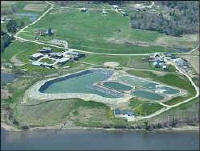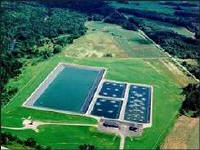|












2003
Maine Wastewater Salary Survey as conducted by the Maine Wastewater Control
Association

2003 Maine
Wastewater Rate Survey conducted by the Maine Rural
Water Association

Maine DEP Monthly
O & M Newsletter
Maine and WEF's
Operation Forum
Penobscot Watershed and Development of a TMDL
EPA Binational Toxics
Strategy
Maine Rural Water
Association
Maine Wastewater
Operator Certification
Guide
Maine Is Technology
Newsletter
Maine
Wastewater Control Association
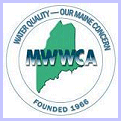
Maine
Wastewater Engineering
Firms
| |
Clinton Water District
Case Study
of the Facultative Lagoon System
By Janet Abrahamson - Maine
Rural Water Association
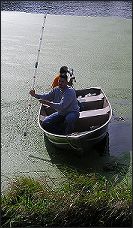 The Clinton Water District provides a secondary level of wastewater treatment by
use of a facultative lagoon system. Clintonís lagoon system was constructed in
1987. The two lagoons are operated in series and cover approximately 26 acres
and are approximately five feet deep. The Clinton Water District provides a secondary level of wastewater treatment by
use of a facultative lagoon system. Clintonís lagoon system was constructed in
1987. The two lagoons are operated in series and cover approximately 26 acres
and are approximately five feet deep.
Clinton has used the lagoon system to treat the wastewater for their community
of about 350 users for almost twenty years without the removal of sludge. The
DEP has been emphasizing the need for facilities to plan for the disposal of
sludge especially if systems are experiencing process difficulties that could be
attributed to the nutrient cycling in the system.
There are several natural biological cycles that occur in a facultative lagoon
system. When any one cycle gets out of balance, the system will start to
experience process problems. Carbon from the aerated digestion of sludge, which
is dissolved in the water and from atmospheric influences, will provide a carbon
source that is used by the algae and other plants in the presence of sunlight to
produce simple sugars and oxygen as a byproduct. The simple sugars become the
organic material that makes up the algae.
When there is no sunlight present, the algae respire and use up oxygen and
produce carbon dioxide. During anaerobic decomposition, anaerobic microorganisms
break down the solids forming very different products. The carbon is then
converted to methane gas and soluble alcohols, which is BOD and uses up oxygen,
instead of carbon dioxide.
Sulfur is converted in to hydrogen sulfide gas and some insoluble iron sulfides
are precipitated out. The insoluble phosphates in the solids could be
solubilized and become available to the algae, which could cause an algae bloom.
Phosphorus is the energy source and in the genetic makeup of all living things.
The algae eventually die and become part of the sludge layer. When plant
material decays, the phosphorus is released and returned to the lagoon and is
available for reuse by the algae and bacteria.
Though much of the phosphorus is not available since it is in an insoluble form,
changes to the water chemistry can make it available. When the anaerobic process
overtakes a lagoon due to too much plant growth, algae, or duckweed, there could
be odor issues as well as poor quality effluent.
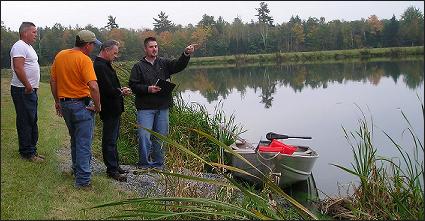 Clinton agreed to participate in a study to determine if an anaerobic
microorganism could be used in the lagoon system to assist in decomposing the
sludge layer during cold weather. This process would prolong the life of the
lagoon before the sludge would need to be removed. Additionally, it would
improve the quality of the water since the microorganisms would be competing
with the algae for the available nutrients in the water. Clinton agreed to participate in a study to determine if an anaerobic
microorganism could be used in the lagoon system to assist in decomposing the
sludge layer during cold weather. This process would prolong the life of the
lagoon before the sludge would need to be removed. Additionally, it would
improve the quality of the water since the microorganisms would be competing
with the algae for the available nutrients in the water.
In October of 2005, the study began with the measurement of the sludge layer
throughout the first lagoon. A core sampler was used along with a GPS unit to
track sample locations so that the same points could be measured at the same
location each time. Surprisingly, there wasnít as much sludge as one would
expect after 20 years of usage! The treatment process had reduced solids
considerably.
After about a month of treatment with the archaea there was a noticeable
difference in the appearance of the lagoon. There was less anaebana, a blue
green algae or cyanobacteria, at the end of the first lagoon. Additionally,
there was less floating sludge on the surface and dispersed algae suspended
throughout the depths of the lagoon, which allowed one to see deeper into the
lagoon. The second lagoon did have more duckweed than at the beginning of the
trial, but that could be a coincidence or perhaps due to the presence of many
more ducks migrating.
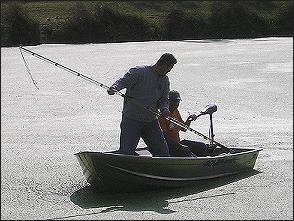 In December 2005, a second core sampling was taken. This showed a 17% reduction
in the sludge throughout the first lagoon after application of the archaea for 6
weeks. The reduction in sludge was based on the additive depths of sludge for
all 60 points compared to the following measurements after treatment at all 60
points. In December 2005, a second core sampling was taken. This showed a 17% reduction
in the sludge throughout the first lagoon after application of the archaea for 6
weeks. The reduction in sludge was based on the additive depths of sludge for
all 60 points compared to the following measurements after treatment at all 60
points.
When the study first began in October, the sludge depths at 60 sampling points
spread out all around the lagoon totaled 762 inches. By February 15th the total
had been reduced to 502 inches a 34% reduction. The goal is to keep adding the
anaerobic microorganisms to increase sludge digestion rates until a 50%
reduction is accomplished.
About the Author
Janet Abrahamson began her career as Maine Rural Water
Associationís Wastewater Technician in May 2002. Janet has over 20 years of
experience in the wastewater field. She holds a Bachelor's degree in chemistry
from the University of Lowell, in Lowell Massachusetts and a Grade V Biological
Operator's Certificate.
More information about the author......
|
